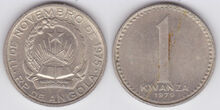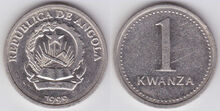| Kwanza | |
|---|---|

| |
| 2012 coin | |
| General information | |
| Country | |
| Value |
1.00 kwanza |
| Years |
1977–2012 |
| Measurements and composition | |
| Mass |
|
| Diameter |
|
| Thickness |
1.85 mm |
| Composition |
|
| Appearance | |
| Shape |
round |
| Alignment |
medallic |
| Edge |
|
| Obverse |
|
| Reverse |
|
| v · d · e | |
The 1 kwanza coin is a circulation piece of the current Republic of Angola and former People's Republic, issued in three types since 1977. The first coin of the denomination, part of the initial kwanza monetary system, was issued annually from 1977 to 1979. After the disestablishment of the first kwanza in 1990, Angola used the novo kwanza ("new kwanza") until 1995, and then the kwanza reajustado ("readjusted kwanza") until 1999. Because these two currencies consisted solely of paper money, a 1 kwanza coin was not produced during their runs. However, in 1999, with the establishment of the second kwanza, a new 1 kwanza coin and banknote made their débuts. As part of the same currency, a redesigned piece (dated 2012) was most recently introduced in 2013.
The coins introduced in 1999 and 2012 currently hold a legal tender face value equivalent to 1.00 kwanza. As part of the defunct first kwanza, the piece struck in 1970s was demonetized shortly after the introduction of the novo kwanza in late 1990.
All three 1 kwanza coins were distributed by the National Bank of Angola (BNA) and produced outside of Angola.
Coins[]
Coin of the first kwanza (1977–1979)[]

1979 coin
Following a lengthy 13-year war (1961–1974), the State of Angola was granted independence from Portugal in 1975. Agostinho Neto (1922–1979), an Angolan communist and revolutionary, installed himself as president, and renamed the country to the People's Republic of Angola. In 1977, the nation adopted the kwanza as its official currency, which replaced the previous escudo at a rate of 1 to 1. The National Bank of Angola commissioned the newly established Cuban Mint in Havana to strike the first series of coins for the new currency, which consists of pieces denominated at 50 lwei, and 1, 2, 5, and 10 kwanzas. The 1 kwanza coin then continued to be struck into 1978 and 1979. Interestingly, the 1977 piece does not bear the date of minting, but the later two issues do.
The 1 kwanza piece is composed of cupronickel, weighs approximately 3.91 grams, and measures 21 millimeters in diameter and approximately 1.85 millimeters in thickness. It has a reeded edge and medallic alignment, and like most coins, is round in shape. The rims of the obverse and reverse are raised, and the latter is decorated with a beaded border.
Displayed in the center of the coin's obverse is a rendition of the emblem of the People's Republic of Angola – which consists of a crossing machete and hoe in the center, above a rising sun and under a five-pointed star. The aforementioned elements in the emblem are enclosed within a circle formed by a branch of cotton (Gossypium) and maize (Zea mays) and half of a gear. An opened book is included below the rising sun, covering portions of the circle, with a scroll bearing the state title of the People's Republic of Angola in Portuguese – "República Popular de ANGOLA" – underneath. Written above the emblem on the coin, extending in a clockwise direction from the left to right rims, is the date "11 DE NOVEMBRO DE 1975", which translates to English as "November 11, 1975". Such text indicates the day in which Angola was granted independence from Portugal, not the time of the coin's minting. The state title "RP DE ANGOLA", shortened for República Popular de Angola, occupies the remainder of the coin's periphery, engraved in a counterclockwise direction below the central emblem. Both of the legends are separated by two circular points. Inscribed on two lines in the middle of the reverse is the face value "1 KWANZA". The numeral in the value takes up a significant amount of space, and is much larger than the word "KWANZA" below it. On coins made in 1978 or 1979, the Gregorian date of minting is written in a small font under "KWANZA". Examples minted in 1977 simply have an empty space between the word and the bottom rim.
The total mintage of the first 1 kwanza coin is currently unknown. Only business strikes are known to have been produced.
Coins of the second kwanza (1999–2012)[]
1999 coin[]

1999 coin
In 1979, President Agostinho Neto went to Moscow seeking a treatment for cancer. However, Neto died while undergoing surgery that year, and José Eduardo dos Santos (1942–) was subsequently elected as president. He maintained communist rule in Angola until 1992, when the current Republic of Angola was established. In spite of the change in government, dos Santos remained in power, having won the nation's first (and to date only) multi-party election. In 1999, high inflation of the kwanza reajustado prompted the introduction of the second Angolan kwanza. That year, under contract with the National Bank of Angola, the South African Mint in Pretoria, South Africa, struck a series of coins for the new currency in denominations of 10 and 50 cêntimos, and 1, 2, and 5 kwanzas. All of these coins were struck exclusively in 1999. A banknote denominated at 1 kwanza was introduced as well, but was gradually replaced in favor of the coin.
The 1999 kwanza coin is composed of nickel-plated steel. It has a mass of approximately 4.5 grams, a diameter of 21 millimeters, and a thickness of roughly 1.85 millimeters. The piece uses medallic alignment and bears a reeded edge, and is round in shape. The rims on both sides are raised, and that on the reverse is decorated with a beaded border.
Engraved in the middle of the obverse is the emblem of the Republic of Angola. Such a symbol is virtually identical to the emblem of the People's Republic, except the state title in the scroll reads "República de ANGOLA" (English: "Republic of Angola") instead. The same text, albeit rendered as "REPÚBLICA DE ANGOLA", is inscribed above the emblem on the coin, extending clockwise from the left to right peripheries of the obverse. In this legend, the acute accent in the "U" is shown simply as a horizontal line. Printed in Western Arabic numerals in the opposite direction below the emblem, at the bottom of the piece, is the Gregorian year of minting, "1999". The face value "1 KWANZA" is written on two lines in the center of the reverse. Like on the 1970s coin, the number "1" occupies a considerable amount of space, and is significantly larger than the accompanying word.
The total mintage of the 1999 kwanza is unknown. Only business strikes of this type were produced.
2012 coin[]
For nearly thirteen years after the introduction of the second kwanza, no coins were produced for Angola. Also, because of increased inflation during the first half of the 2000s, coins gradually disappeared from circulation in Angola. On June 26, 2012, the 2nd National Assembly of Angola approved legislation authorizing the National Bank of Angola to issue a new series of coins and paper money. According to Macau-based news service Macauhub, BNA Governor José de Lima Massano suggested that "putting metal coins back into circulation [in Angola]... would improve price circulation and relieve the problem of a lack of change in the retail sector." The service also indicated that "the aim [of the new coins and banknotes] was to boost economic activities in [Angola] and make the kwanza part of an international quality standard, with greater security, a better aesthetic, and to give it greater credibility overall." In December 2012, Angola commissioned Goznak, a Russian state-owned corporation, to mint the new coins in denominations of 1, 2, 5, and 10 kwanzas, and to also print the updated banknotes. Manufactured at the Saint Petersburg Mint, the coins were officially unveiled at a ceremony on January 30, 2013, and entered circulation on February 13 of the same year.
The 1 kwanza coin of the 2012 series (pictured above) is composed of brass-plated steel, weighs 5 grams, and measures 22.1 millimeters in diameter and about 1.85 millimeters in thickness. It has medallic alignment and a plain edge, and is round in shape. The rims of both the obverse and reverse are raised and undecorated.
Displayed in the middle of the obverse, within a circular border, is the logo of the National Bank of Angola – which consists of a five-pointed star inside of a circle of cotton, coffee (Coffea), maize, and half of a gear, with the "BNA" initials of the Portuguese Banco Nacional de Angola covering the bottom portion of the circle. A background consisting of a traditional textile-like pattern encompasses all of the area outside of the border. Engraved on it, along the upper rim of the piece, is the text "BANCO NACIONAL DE ANGOLA". Such a legend commences at the left periphery of the obverse and extends clockwise to the right. The Gregorian date "2012" is printed horizontally in an italic font at the bottom of the piece, in the outer decorated portion. Written in the middle of the reverse, also inside of a circular boundary, is the face value "1 kwanza". Such text appears left-aligned and inscribed in italics. As on the earlier kwanza coins, the numeral "1" shown in a significantly larger font than the following word. At the right side of the inner circle is another design, which is partially concealed by the letters "za" and part of the "n" in "kwanza". Just like on the obverse, the area outside of the border is occupied by a decorative background consisting of traditional designs.
The total mintage of the 2012 1 kwanza coin is currently unknown. Only business strikes were produced.
References[]
- Numismatic Guaranty Corporation website
- Numista (English) (French)
Angolan kwanza on the English Wikipedia
Ангольская кванза on the Russian (русский) Wikipedia
- Numismatic Dimensions – Coins of Angola
- Goznak – Goznak has executed a large export order (English) (Russian)
- World of Coins – Sub Saharan Africa
- Money Museum of Feodosia – Coins of the Republic of Angola (English) (Russian) (Ukrainian)
- Macauhub – New bank notes and coins due to go into circulation in Angola in 2013
| Angolan kwanza | |
|---|---|
| Banknotes | 1 Kz • 5 Kz • 10 Kz • 20 Kz • 50 Kz • 100 Kz • 200 Kz • 500 Kz • 1000 Kz • 2000 Kz • 5000 Kz • 10,000 Kz • 50,000 Kz • 100,000 Kz • 500,000 Kz • 1,000,000 Kz • 5,000,000 Kz |
| Coins | 10 c • 50 c • 50 lw • 1 Kz • 2 Kz • 5 Kz • 10 Kz • 20 Kz • 50 Kz • 100 Kz |
| Miscellaneous | Cêntimo • Central Bank of Angola • Lwei |
